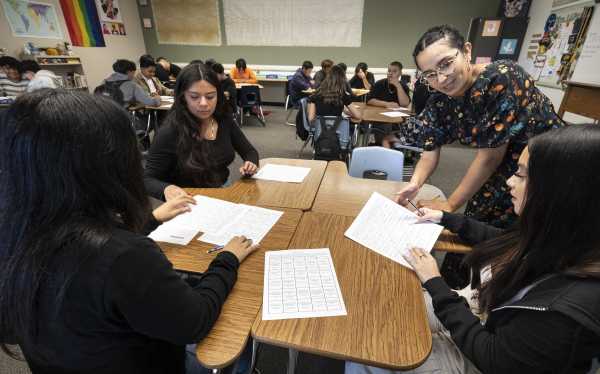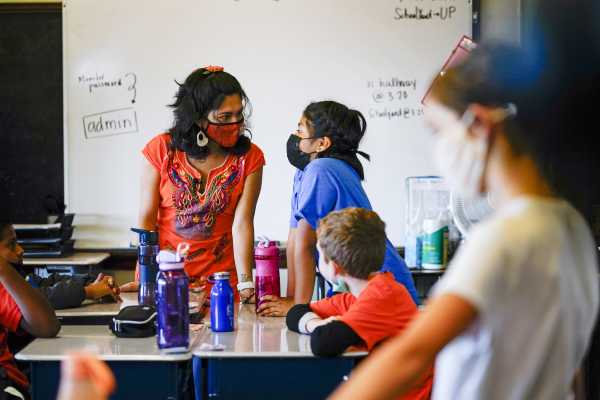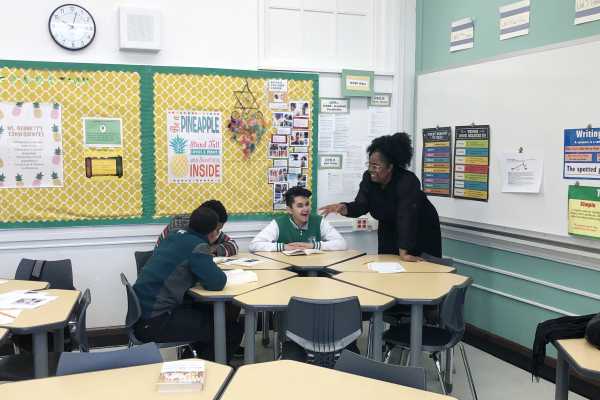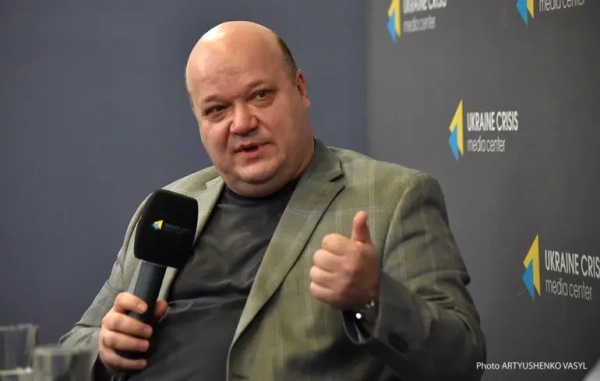
With schools reopening across dozens of states this month, some education leaders are ringing the alarm: There aren’t enough teachers to fill open positions right now.
In Texas, teachers are deserting the classroom at high rates, with Houston alone reporting nearly 1,000 vacancies in early August. In Maryland, more than 5,500 teachers reportedly left the profession in 2022, leaving Baltimore with an estimated 600 to 700 vacancies going into the fall.
Department of Education officials in Pennsylvania are calling that state’s shortage a “crisis,” and experts there say the state will need “thousands” of new teachers by 2025.
Kansas is facing what has been called the most severe teacher shortage it has ever had: about 1,400 teaching jobs are unfilled. In Florida, there are about 8,000 teacher vacancies, up from 5,000 at the start of school last year. The shortage is reportedly also dire in other states, including Nevada, California, Illinois, Arizona, and Missouri. Some experts say that even school districts that don’t usually face shortages are struggling with vacancies, and it’s hard to hire teachers even for subjects that are typically easy to fill.
Meanwhile, teachers have made it plain that they are unhappy. Seventy-four percent of respondents in the American Federation of Teachers’ June survey of nearly 2,400 members were dissatisfied with the job, up from 41 percent in 2020, and 40 percent said they’d probably leave the profession in the next two years.
Teacher shortages are nothing new. The teaching profession has been perennially plagued by shortages for the last 50 years. But what’s happening this year might seem like a perfect storm: Long-term trends in the profession and a healthy job market in other fields are colliding with a couple of extremely difficult years in the classroom.
A mass exodus from teaching, as more teachers quit and fewer newly minted educators are available to take their place, feels like it makes intuitive sense this year.
But is it actually happening? The US does not collect timely, detailed national data about teacher employment, so it’s difficult to definitively conclude whether there is a national teacher shortage going into the 2022-23 school year. That has led to practitioners, education policy experts, and union leaders talking past one another.
The first uncertainty is how a shortage is even defined. “There are so many different measures of teacher shortages, and there’s no national standardized definition of what a teacher shortage is,” said Josh Bleiberg, a post-doctoral researcher studying school reform at the Annenberg Institute at Brown University, who recently co-wrote a working paper about the challenges of studying the teacher labor market in real time.
On the one hand, local news outlets are reporting on shortages in response to local vacancy numbers provided by school district leaders and principals, and union leaders are speaking out based on survey data from their member bases or other preliminary information. And on the other hand, there are policy experts looking at state-level data who are more cautious about making declarative teacher turnover claims about what’s happening nationwide.
“People talk about shortages from different perspectives and both of those perspectives are right, but they can lead to different conclusions,” said Matt Kraft, a professor of education and economics at Brown University who co-wrote the paper. “So if I’m a school leader, I can very authentically say, ‘I don’t have the people I need.’ And then someone else can be sitting at the state or national level and be looking at the numbers and saying, ‘There is no shortage.’”

While these data challenges complicate the teacher shortage debate, educators, education leaders, and experts at every level seem to agree that a crisis lies in how little America values its teachers and how transparent this has become in the last few years.
“There is definitely a crisis of morale and confidence. The belief that one can do good work and do good for young people and have a rewarding, satisfying career in teaching has gone down the tubes,” said Dirck Roosevelt, the director of doctoral specialization in teacher education at Columbia University’s Teachers College. “That’s been coming for a long time.”
What we know about the teacher shortage
Some communities have always struggled to hire teachers. Urban school districts that typically serve Black and brown students have traditionally faced shortages: Richard Ingersoll, a professor of education and sociology at Penn GSE and leading expert on the country’s teaching force, told Vox that “high-poverty, high-minority, urban, and rural public schools” have had among the highest rates of turnover, based on analyses of several decades.
“When we talked about teacher shortages in 2015 or 2010 or even 2000, we were talking about shortages in communities of color, in particular,” said Jacqueline Rodriguez, the vice president of research, policy, and advocacy at the American Association of Colleges for Teacher Education. “We were talking about communities that were traditionally under-resourced.”
This year, she’s seeing more examples of those struggles spreading to wealthier, whiter districts, too. In Virginia, wealthier communities in the Washington, DC, suburbs, including Alexandria, Crystal City, and McLean, usually have no trouble attracting teachers, but “they’re seeing huge percentage decreases in submissions of applications, or, in some cases, they don’t have any to choose from,” she said. That situation would be nothing out of the ordinary in Norfolk, Virginia, where the schools in the poorest neighborhoods have struggled for years to keep teachers.
“The types of inequities that students had to navigate over the last several decades have always existed for students of color, but they are only now permeating white communities,” Rodriguez said. “And we’re starting to recognize that the teacher shortage is not simply about the pandemic.”
The American teaching workforce is huge: In 2018, there were 3.5 million teachers in public and charter schools. So far, there is no comprehensive national data about teacher turnover, so the understanding of teacher shortages rests on these anecdotes from individual schools, districts, and some states.
“I think what is clear among all the noise is that there hasn’t been a mass exodus. In some districts there have been elevated rates of teachers leaving,” said Heather Schwartz, senior policy researcher at the RAND Corporation. “‘Mass exodus’ is an undefined term. But we may all think of it as doubling or tripling the normal attrition rate and we have not seen that.”
Some data sources suggest that the number of teachers really has declined, even if it hasn’t yet hit mass exodus levels. There were about 270,000 fewer school staffers in July 2022 — including teachers, bus drivers, counselors, and librarians — than there were in January 2020, according to preliminary data from the Bureau of Labor Statistics.
Bleiberg and Kraft, using both national and state-level data, found that overall employment in the K-12 labor market declined by 9.3 percent at the onset of the pandemic and was still 4 percent below pre-pandemic levels in March 2022.
A survey from RAND of 291 school district leaders, released in July, found that 58 percent of district leaders foresee a small shortage this year and 17 percent anticipate a large shortage. The survey also found that more than three-quarters of district leaders said that they have expanded their teaching staff, in some cases including substitute teachers, above pre-pandemic levels as of spring 2022.

Ingersoll pointed to heavy pre-retirement quit rates — teachers leaving the profession who aren’t old enough to retire — though the evidence so far is largely local or anecdotal.
“In economic downtimes, there won’t be a surge in retirement and quitting. Sure, teaching may make people unhappy, but if there aren’t [other job] options out there, people won’t leave,” he said. “As the economy improves, there will probably be a huge pent-up surge in teacher quitting and teacher retirement. And in fact, it looks like that’s what’s happening.”
Why there is record teacher dissatisfaction
The usual culprits for teacher dissatisfaction are ever-present. About 75 percent of pre-K to grade 12 teachers who participated in the AFT survey reported that conditions have changed for the worse over the past five years.
The reasons included their workload, greater responsibilities, unrealistic expectations, student behavioral issues, pay that doesn’t keep up with inflation, a lack of support from school leadership, and a lack of support from parents. About 74 percent of respondents said they would not recommend the teaching profession to a prospective new teacher. (Other large surveys of teachers from the National Education Association, the largest labor union in the country, and RAND tell a similar story.)
While these factors have been at the root of teacher satisfaction for a long time, experts are identifying new stressors that, coupled with burnout, are pushing teachers over the edge.
“There’s been a whiplash during the pandemic. At the beginning, teachers were celebrated and told they should be paid a million dollars. Later on, they were told they were incredibly selfish,” said Roosevelt, of Columbia University. Teachers were viewed as heroes for being on the front lines during the early days of the pandemic, with many of them quickly transitioning to online instruction to keep the learning going. But when it came time to return to the classroom, at the risk of sacrificing their health and that of their family’s, many teachers wanted to draw the line.
“The massive demoralization of the teaching force is a huge problem. There are lots of indications of teacher unhappiness and teachers expressing a desire or an intent to leave the profession,” said Roosevelt. “If teachers are profoundly demoralized, that’s going to affect the quality of their teaching, sooner or later.”
Teachers also face a lack of trust that’s been growing for decades, Roosevelt said, with the “relentless tsunamis of mandates related to what to teach, what not to teach, and the endless folly of how to measure everything.” Mandates, restrictions, and top-down oversight has eroded teachers’ professional democratic autonomy, according to Roosevelt.
Though salaries do influence a teacher’s decision to remain in the field, they haven’t historically been the biggest factor in the decision. “When we analyze the data on teacher quitting and turnover, salaries and benefits do matter but not as much as how much say, how much voice, and how much support teachers say they have,” said Ingersoll. “Those kinds of factors are more frequently cited by teachers as what made them decide to leave.”
Still, the “teacher pay penalty,” the reality that teachers are paid less than their non-teacher college-educated counterparts, has gotten worse over time. A new study from the Economic Policy Institute, an independent nonprofit think tank, found that the weekly wages of teachers have remained relatively flat for nearly three decades.

For Ivory Bennett, 31, formerly a 12th grade English teacher in Dallas and her school’s cheerleading coach, the decision to leave the profession just before the start of the 2021 school year, which would have been her seventh year in the classroom, was a difficult one. “It was very hard, but I had to do it for three reasons,” Bennett told Vox.
First, she felt undervalued in her school community. “I felt like I was being hazed, constantly. I was treated unkindly and did not feel respected or supported. The vibe was soul-sucking and joy-depleting. Also, there was little emphasis on actual academia and too much emphasis on state testing,” she said. Bennett realized that teaching took a toll on her physical and mental well-being. “I was being treated with so much disregard and ultimately decided to prioritize my health,” she said.
And then there’s the compensation. As a teacher with a master’s degree in education, Bennett said she wasn’t getting paid enough for what was expected of her. During her final year as a teacher, she earned $57,500, up from about $26,000 during her first year as a teacher in Oklahoma City.
She walked away knowing that her students probably wouldn’t have an English teacher or a cheer coach that year. Bennett now works for a nonprofit where she trains first- and second-year teachers.

“I think it’s worse now than it has been,” said Roosevelt. “There has not been a golden era for teachers in this country, but there were many generations where a teacher could find some honor in the work in some parts of society. They wouldn’t necessarily get paid well, but they felt they were doing something that was valuable and important. There was a certain camaraderie that existed, and we just don’t have that now.”
State-level legislation, like bans on how teachers talk about race, gender identity, and sexual orientation, along with discussions about arming teachers in schools and mask and testing mandates, have only exacerbated existing tension around school-based culture wars, going back to the fight over whether to teach evolution or the Bible.
The tug-of-war over whether parents, teachers, district administrators, or state legislators make the decisions is finally driving more teachers out. About 88 percent of teachers in the AFT survey said education was “becoming too politicized” where they worked and 82 percent said that, where they worked, educators were becoming targets of political and ideological attacks.
“We as a public, and as legislators, decided that they didn’t do a good enough job of making decisions as experts in their own fields, so we need to start legislating how and what they teach,” Rodriguez said. “We undervalued the teaching profession, and then we legislated against what teachers knew was in the best interest of kids, which includes things like social-emotional learning, trauma-informed instruction, and being culturally responsive.”
Teachers are worried about how vacancies would impact their ability to be effective in the classroom.
“In the last two years, I’ve had to be five teachers — for a semester long in two cases — in addition to my own class load as we have people leave mid-year or can’t find candidates to hire,” said Nick Clark, a Fort Worth, Texas, high school calculus teacher who has been teaching for 15 years. “I don’t have the time to meaningfully plan, grade, or mentor the extra students and still be highly effective for my own students.”
Some states like Texas are looking into loosening certification requirements. Others are relying on long-term substitutes, and Florida is considering allowing veterans without bachelor’s degrees or teaching experience to lead classrooms. Other districts are having teachers cover extra classes and sometimes asking administrators or district personnel to step in. Some are hiring teachers on the spot at job fairs, increasing salary offers, or enticing educators with four-day workweeks.
Teachers have a bigger impact on student achievement than any other factor at school, and experts warn that some quick fixes could backfire if they recruit teachers who are unprepared.
One-fifth of the new teacher hires in the country have never had any practice with kids ahead of time, Ingersoll said, and beginning teachers have among the highest rates of turnover of any group of teachers. Overall, more than 44 percent of new teachers leave the profession within five years. The lower entry standards also risk de-professionalizing the field.
The constant turnover prevents educators from building a pool of knowledge about best practices within the field and doesn’t allow young practitioners to learn from older ones. “You certainly don’t get people sticking around long enough to gain the protections of tenure, or the self-confidence to stand up to policies that they think are wrong or to advocate for good policies,” said Roosevelt.
Students, perhaps, have the most to lose in the face of teacher shortages. “Their learning losses are stacking up, and their self-confidence declines,” Clark, the high school teacher, said. “I do my best to be available, but having 300+ students just isn’t tenable. The extra load and duties make coming back less and less appealing every year.”
Will you support Vox’s explanatory journalism?
Millions turn to Vox to understand what’s happening in the news. Our mission has never been more vital than it is in this moment: to empower through understanding. Financial contributions from our readers are a critical part of supporting our resource-intensive work and help us keep our journalism free for all. Please consider making a contribution to Vox today.
Sourse: vox.com






